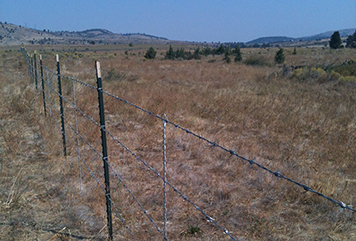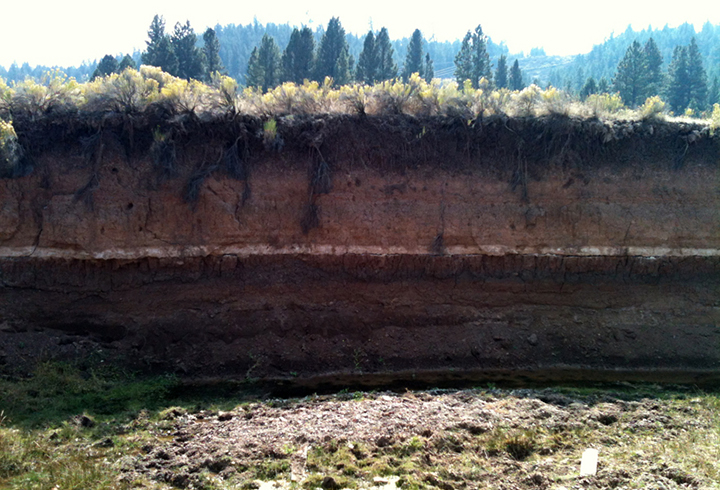Transforming an Oregon Watershed, Once Marred by a Gasoline Spill, into Fish-Friendly Habitat
JULY 15, 2013 -- The Warm Springs Reservation in central Oregon is a vast, solitary, and beautiful place. Stretching out from the southeastern flanks of Mt. Hood, the reservation is home to members of the Confederated Tribes of the Warm Springs Reservation of Oregon. The reservation is bisected by one of Oregon's most scenic roads, Highway 26. Driving down this road on a hot and dry summer day, you'll see the rich, dark forest transition to sagebrush steppe and high desert. You'll see hazy mountains in the distance, with creeks meandering across the foreground. Today, you'd never know a tanker truck ran off this idyllic road in 1999, spilling more than 5,000 gallons of gasoline into Beaver Butte Creek, just above where it meets Beaver Creek. The spill impacted Chinook salmon, steelhead trout, and other fish and wildlife that lived in or downstream of Beaver Butte Creek. It killed the plants and contaminated the soil around the creek as well. Cleanup efforts began immediately. A trustee council was formed to assess the environmental damages and plan for restoration. The council included representatives of the Confederated Tribes of the Warm Springs Reservation of Oregon, the National Oceanic and Atmospheric Administration (NOAA), and U.S. Fish and Wildlife Service. Using funds from the settlement with the company responsible for the spill, the Trustees have chosen a range of restoration projects to improve conditions for steelhead trout and Chinook salmon throughout the Beaver Creek watershed. The restoration plan focuses on steelhead in particular because they are an endangered species, already on the brink of extinction. In addition to the gasoline spill, there are a variety of other factors that have degraded the once-abundant natural resources on the Warm Springs Reservation. Logging and human-caused changes to the natural regime of wildfires have transformed the forests. Roads and development have relocated, and in some cases, blocked streams. Wild horses and cattle have packed down the soils and reduced vegetative cover, increasing erosion along the stream banks. The first restoration project to offset impacts from the gasoline spill took shape in 2011. Since then, four more projects have been built, ranging from riparian fencing to road removal. There are more to come. With a creative and thoughtful approach, the Confederated Tribes of the Warm Springs Reservation of Oregon and the other trustees are stretching the settlement dollars by leveraging them with other funding sources to provide the greatest benefit to injured fish and wildlife. Here are some of the highlights:

Red Lake, Happy Valley, and Quartz Creek Riparian Fencing Projects
The problem: Wild horses and free-roaming cattle. These large animals eat plants along the creeks and stomp down the dirt on the stream banks and floodplains, increasing erosion and degrading water quality. The solution: Fencing. So far we have installed four miles of fence along stream banks, protecting 150 acres of riparian (stream-side) habitat throughout the Beaver Creek Watershed while also helping ranchers manage their livestock. An added benefit of the fencing projects? Providing employment to 15 tribal members. That's what we call a win-win.
S512 Large Wood Project and S501 Road Removal Project
The problem: Simplified streams that don't provide good habitat for fish. Logging, road building, and other types of development have removed trees from the areas near streams, where the trees normally would fall into the creeks and provide nooks and crannies for fish to hide in and eat bugs.

The solution: Adding large wood to the stream to give fish places to hide, rest, and eat. In some cases we have also decommissioned old, abandoned logging roads and planted them with native trees and shrubs so that, eventually, nature can take over the work.
Quartz Creek Stream Restoration


The problem: Streams that have eroded so badly they now have 20-foot-high banks that are completely disconnected from the floodplain. The eroding stream banks release small landslides of fine dirt into the stream, making the water cloudy and covering the gravel that salmon need to spawn. The solution: Think like a beaver. This year the Tribe plans to install two beaver dam–mimicking structures on Quartz Creek to help dam up the water and catch eroding dirt as it is moving downstream. Hopefully, actual beavers eventually will move back into the creek and continue this work.
 An official website of the United States government.
An official website of the United States government. 

